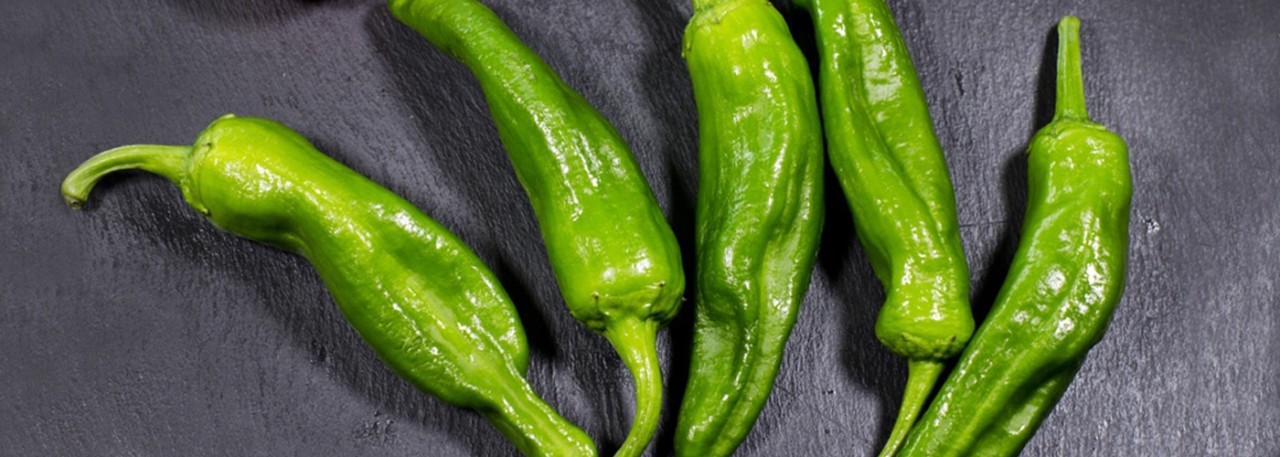.png.transform/rendition-xs/image_image%20(1).png)
Pimiento de Gernika/Gernikako Piperra PDO
The peppers protected by this geographic indication are fruits of the genus Capsicum annnuum L., belonging to the local Derio and Iker varieties.
Tasting notes
The fruit is picked before it is fully ripe (the peppers are still green). When they are picked they should be between 2.36 and 3.54 in (6 and 9 cm) long and from 0.79 to 1.18 in (2 to 3 cm) at their widest point. The stalk is long and thin and the pepper itself is an elongated conical, often slightly curved shape. It has a large number of flat, rounded edible seeds, which in the young fruit are an off-white color. As it ripens, the peppers start to turn a yellowish color. The color tone of the pepper varies from medium to dark green, slightly shiny and with even coloration. The skin is thin, does not contain parchment and is not leathery. The flesh is firm, smooth and sweet-tasting.
Production / Processing method
Planting is done outdoors or under cover. Density is 3-4 plants per square meter. The soil is usually covered with a sheet of polyethylene to prevent the growth of weeds.
It is important that the plants are not over-watered in the early stages, as this encourages a stronger root system to develop, allowing the plant to stay upright without bending over throughout the production process. Treatments should also be kept to a minimum, applying only those that are necessary for the fruit to grow healthy. Wherever feasible, only biological pest control treatments or techniques should be used.
Harvesting takes place mainly between April and November, when the product is at its optimum stage of development. The harvest is staggered, making as many runs as are required.
After picking, the peppers are transported in boxes or rigid containers to the handling plant, taking care to avoid any bruising and other damage. Registered farms can only grow authorized varieties of green pepper.
Traditionally, the packing and packaging work is done on each individual plantation.
As the product is harvested when it is at an optimum stage of its development, it is harvested daily and packed the same day.
Processing and packing plants must have systems that guarantee unloading is done without harming the quality of the peppers in any way. They must also be correctly ventilated and kept at the correct temperature and relative humidity.
Packing is done manually, with great care to ensure the product's physical properties are not damaged in any way.
The product can only be sold direct to the consumer in retail outlets, in a sealed pack that enables the peppers to be seen easily, and protects and preserves the product correctly. The packaging must be labeled as set out in the Product Regulations. The contents of each pack must be uniform in terms of variety, size, coloring and ripeness.
Geography / Relief and climate
The Atlantic region of the Basque Country, where the Pimiento de Gernika pepper is grown, is a mountain farming area where the most important activities are livestock farming, horticulture and forestry. The soil is limy with an abundance of organic matter.
The area's Atlantic climate ensures mild temperatures and high rainfall; there is no dry month and the wettest time of the year is autumn and winter. The province of Vizcaya has a lower annual rainfall than Guipúzcoa. In Vizcaya, rainfall exceeds 1,000 mm but is less than 1,500 mm, except in a few mountain areas.
The Atlantic Ocean has a considerable influence on this climate, as westerly winds blow along the whole of Europe's western coastline; the production area is on a latitude where the predominant general flow is from west to east. This means that air masses whose temperatures have been lowered by coming into contact with warm oceanic waters, reach the coast and cause low temperature variations between night and day, or between summer and winter.
Temperatures are mild, with an annual average of 13ºC and variation of 11ºC, meaning that winters are generally not excessively cold. Summers are normally cool, but there may be short periods of very hot weather, with temperatures reaching 40ºC, especially when there is a southerly wind blowing from Africa and heating up further as it descends towards the Bay of Biscay region.
Regulatory Council
Consejo Regulador de la DOP Pimiento de Gernika/Gernikako Piperra
Bº de Muntsaratz, 17-A - Torre Muntsaratz
48220 Abadiño (Vizcaya)
Tel: (+34) 946 030 330
Fax: (+34) 946 033 953
euskolabel@euskolabel.net
hazi@hazi.eus
www.euskolabel.net
Sources:
- Spanish Ministry of Agriculture
- Regulatory Council, Pimiento de Gernika/Gernikako Piperra PDO
The skin is thin, does not contain parchment and is not leathery. The flesh is firm, smooth and sweet-tasting.


- /content/dam/en/icex-foodswines/images/products/fruits---vegetables/pimiento-de-gernika-piperra-pdo/Pimiento%20de%20Gernika%20Piperra%20PDO%20carr1.jpg
- /content/dam/en/icex-foodswines/images/products/fruits---vegetables/pimiento-de-gernika-piperra-pdo/Pimiento%20de%20Gernika%20Piperra%20PDO%20carr2.jpg

Abadiño (Basque Country)
